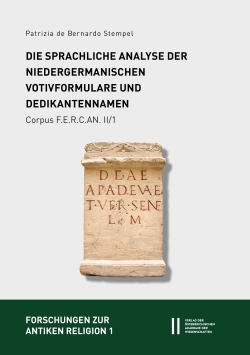


Aufgabe des Corpus „Fontes epigraphici religionum Celticarum antiquarum“ ist es, jene religiösen Inschriften der römischen Welt zu edieren, die einen möglichen keltischsprachigen Hintergrund haben. Dabei werden die darin enthaltenenen Votivformulare mit den jeweiligen Götternamen aus sprachwissenschaftlicher, epigraphisch-historischer und ikonographischer Sicht untersucht und klassifiziert.
Dieser Band befasst sich mit den religiösen Testimonien der Provinz Germania inferior. Sämtliche niedergermanische theonymische Formulare (35 für Einzel- und zwei für paarige Gottheiten sowie 61 zur Anrufung von Gruppen göttlicher Mütter, der sog. Matronen bzw. „Matres“) werden einzeln in dem hier vorliegenden ersten Teilband sprachhistorisch analysiert — mit besonderem Augenmerk auf Kontaktphänomene, sowohl untereinander als auch zu anderen Bereiche der Keltiké und zu den Panthea der klassischen Antike. Es folgt eine sprachgeschichtliche, semantische und synkretistische Bilanz der untersuchten Götternamen zusammen mit einer Typologie der niedergermanischen Votivformulare und einer ebenfalls sprachhistorischen Analyse der Personennamen mit keltischem Hintergrund, die in den betreffenden Inschriften, egal in welcher Funktion, enthalten sind.
Eine methodologische Einführung in das Studium der keltischen Religion(sphas)en und in die Klassifizierung von Götternamen nach verschiedenen Parametern sowie ein Anhang zur Glottogenese der keltischen Sprachvarietäten und ihrer graduellen Ablösung aus der indogermanischen Grundsprache runden das Werk ab.
Gedruckt mit Unterstützung des Fonds zur Förderung der wissenschaftlichen Forschung (FWF).

The task of the corpus “Fontes epigraphici religionum Celticarum antiquarum” is to edit those religious inscriptions from the Roman provinces which may have a Celtic-language origin. As part of this, the votive formulae with the pertinent gods’ names that fall into that category are examined from the linguistic, epigraphic, historic and iconographic perspectives and classified.
This volume deals with the religious testimonials from the province of Germania inferior. In this first fascicle, all of the theonymic formulae from Lower Germania (35 for individual gods and two for paired deities, as well as 61 invoking groups of female deities, the so-called “matres” or “matronae” – the mothers) are analysed individually in relation to the history of language, paying particular attention to any phenomena indicating contact, either between these inscriptions or with other areas occupied by the Keltike or the panthea of classical Antiquity. This is followed by a language history, semantic and syncretic summary of the names of the deities investigated, together with a typology of the votive formulae from Germania inferior and a language history analysis of the names of people with a Celtic background mentioned in the relevant inscriptions, regardless of their particular role.
The work is completed by a methodological introduction to the study of the (phases of) the Celtic religions and the classification of the names of deities based on a range of parameters, as well as an appendix on the development of Celtic language variants and their gradual disappearance from the core Indo-Germanic language.
Printed with the support of the Austrian Science Fund (FWF)
2022,
978-3-7001-8806-3
978-3-7001-9288-6
397 Seiten, zahlr. Farb- und s/w-Abb.
Diese Publikation ist lizenziert unter der Creative-Commons-Lizenz Namensnennung 4.0:
CC BY 4.0
29,7x21cm, gebunden